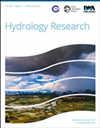Pre- and postprocessing flood forecasts using Bayesian model averaging
IF 2.4
4区 环境科学与生态学
Q2 Environmental Science
引用次数: 2
Abstract
In this study, pre- and postprocessing of hydrological ensemble forecasts are evaluated with a special focus on floods for 119 Norwegian catchments. Two years of ECMWF ensemble forecasts of temperature and precipitation with a lead time of up to 9 days were used to force the operational hydrological HBV model to establish streamflow forecasts. A Bayesian model averaging processing approach was applied to preprocess temperature and precipitation forecasts and to postprocessing streamflow forecasts. Ensemble streamflow forecasts were generated for eight schemes based on combinations of raw, preprocessed, and postprocessed forecasts. Two datasets were used to evaluate the forecasts: (i) all streamflow forecasts and (ii) forecasts for flood events with streamflow above mean annual flood. Evaluations based on all streamflow data showed that postprocessing improved the forecasts only up to a lead time of 2–3 days, whereas preprocessing temperature and precipitation improved the forecasts for 50–90% of the catchments beyond 3 days lead time. We found large differences in the ability to issue warnings between spring and autumn floods. Spring floods had predictability for up to 9 days for many events and catchments, whereas the ability to predict autumn floods beyond 3 days was marginal.使用贝叶斯模型平均进行洪水预报的前处理和后处理
在这项研究中,对水文综合预报的前处理和后处理进行了评估,特别关注119个挪威集水区的洪水。两年的ECMWF温度和降水综合预报,提前时间长达9天,用于强制运行的水文HBV模型建立径流预报。将贝叶斯模型平均处理方法应用于温度和降水预报的预处理和径流预报的后处理。基于原始、预处理和后处理预测的组合,为八个方案生成了综合流量预测。使用两个数据集来评估预测:(i)所有流量预测和(ii)流量高于年平均洪水的洪水事件预测。基于所有流量数据的评估表明,后处理仅在2–3天的交付周期内改善了预测,而预处理温度和降水量在3天交付周期后改善了50–90%集水区的预测。我们发现,春季和秋季洪水的预警能力存在很大差异。对于许多事件和集水区,春季洪水的可预测性长达9天,而预测3天以上秋季洪水的能力微乎其微。
本文章由计算机程序翻译,如有差异,请以英文原文为准。
求助全文
约1分钟内获得全文
求助全文
来源期刊

Hydrology Research
Environmental Science-Water Science and Technology
CiteScore
5.30
自引率
7.40%
发文量
70
审稿时长
17 weeks
期刊介绍:
Hydrology Research provides international coverage on all aspects of hydrology in its widest sense, and welcomes the submission of papers from across the subject. While emphasis is placed on studies of the hydrological cycle, the Journal also covers the physics and chemistry of water. Hydrology Research is intended to be a link between basic hydrological research and the practical application of scientific results within the broad field of water management.
 求助内容:
求助内容: 应助结果提醒方式:
应助结果提醒方式:


